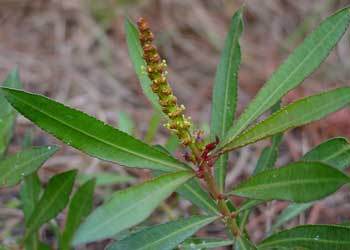Contents:
Common Names | Parts Usually Used | Plant(s) & Culture | Where Found | Medicinal Properties | Biochemical Information
Uses | Formulas or Dosages | Warning | Bibliography
Scientific Names

- Stillingia sylvatica L.
- Euphorbiaceae
Common Names
- Cockup hat
- Marcory
- Queen’s delight
- Queen’s root
- Silver leaf
- Yaw root
Parts Usually Used
Root
Back to Top

Description of Plant(s) and Culture
Stillingia is a perennial plant; its stem grows 2-4 feet high, contains an acrid milky juice and bears alternate, sessile leaves that have a somewhat leathery texture. The yellow, petalless flowers grow in a terminal spike with the female flowers at the base. The fruit is a 3 lobed capsule.
Back to Top
Where Found
Native of the pine barrens and sandy soils of the southern states of the United States.
Back to Top
Medicinal Properties
Alterative, astringent, cathartic, diuretic, emetic
Back to Top
Biochemical Information
Stillingine, which is an alkaloid; gum, starch, both a fixed and volatile oil and coloring matter
Back to Top
Uses
A decoction of the root once was used to treat obstinate skin problems and help clear up ulcerations and pain after mercurial treatment for syphilis. Treats chronic laryngeal and bronchial inflammations, leucorrhea, chronic coughs, rheumatism, and chronic liver affections. In large doses, stillingia causes vomiting and diarrhea.
Back to Top
Formulas or Dosages
Use dried, but not more than 2 year old, rootstock.
Decoction: boil 1 tsp. dried rootstock in 1 cup water. Take 1 cup per day, a mouthful at a time.
Tincture: a dose is from 5 to 20 drops.
Back to Top
Warning
Taken internally, the acrid constituents of the fresh plant can cause irritation and symptoms of poisoning.
Back to Top
Bibliography
![]() American Folk Medicine
American Folk Medicine, by Clarence Meyer, Meyerbooks, publisher, PO Box 427, Glenwood, Illinois 60425, 1973
![]() The Herb Book
The Herb Book, by John Lust, Bantam Books, 666 Fifth Avenue, New York, NY. copyright 1974.
![]() Indian Herbalogy of North America
Indian Herbalogy of North America, by Alma R. Hutchens, Shambala Publications, Inc., Horticultural Hall, 300 Massachusetts Avenue, Boston, Massachusetts 02115, 1973
![]() The Yoga of Herbs: An Ayurvedic Guide to Herbal Medicine
The Yoga of Herbs: An Ayurvedic Guide to Herbal Medicine, by Dr. David Frawley & Dr. Vasant Lad, Lotus Press, Twin Lakes, Wisconsin, Second edition, 1988.
![]() Planetary Herbology
Planetary Herbology, by Michael Tierra, C.A., N.D., O.M.D., Lotus Press, PO Box 325, Twin Lakes. WI 53181., Copyright 1988, published 1992
